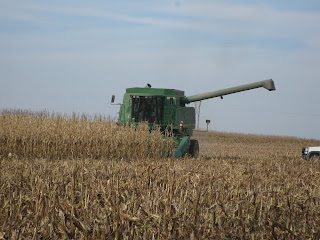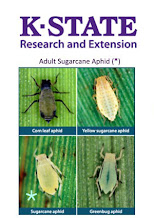Now is the time to plan your fall-applied herbicides!
Sandra L. Wick, Crop Production Agent
 Now that row
crop harvest is progressing and some fall moisture has been received, it is
time to start planning your fall herbicide applications to control winter
annual broadleaf weeds and grasses ahead of corn, grain sorghum or soybeans.
Now that row
crop harvest is progressing and some fall moisture has been received, it is
time to start planning your fall herbicide applications to control winter
annual broadleaf weeds and grasses ahead of corn, grain sorghum or soybeans.
Tillage is still a proven control for winter annuals, however, with the adoption of no-till systems, herbicides have proven to be an effective weed control if certain factors are kept in mind for the pesticide application including timing, the proper rates, herbicide selection and types of applications. Fall applications during late October and through November can greatly assist control of difficult winter annuals and should be considered when performance of spring-applied pre-plant weed control has not been adequate according to Dr. Dallas Peterson, K-State Research and Extension, Weed Management Specialist. The later fall application will allow coverage of the fall winter annual weeds and persist longer in the spring. Henbit, marestail, mustards along with winter grasses, such as downy brome or cheat, frequently are some of the most troublesome weeds we try to manage with these fall herbicide applications.
 Atrazine is labeled in Kansas for fall application over wheat stubble or
after row crop harvest (corn or grain sorghum) any time before December 31, as
long as the ground is not frozen. Consult the atrazine label to comply with
maximum rate limits and precautionary statements when applying near wells or
surface water. No more than 2.5 lbs./acre of atrazine can be applied in a
calendar year on cropland.
Atrazine is labeled in Kansas for fall application over wheat stubble or
after row crop harvest (corn or grain sorghum) any time before December 31, as
long as the ground is not frozen. Consult the atrazine label to comply with
maximum rate limits and precautionary statements when applying near wells or
surface water. No more than 2.5 lbs./acre of atrazine can be applied in a
calendar year on cropland.
Marestail, a winter annual, that can also germinate in the spring and
summer, is an increasing problem in Kansas that merits special attention. “Where
corn or grain sorghum will be planted next spring, fall-applied atrazine plus
2,4-D or dicamba have effectively controlled marestail rosettes and should have
enough residual activity to kill marestail as it germinates in the spring,”
states Peterson. Atrazine alone will not be nearly as effective
post-emergence on marestail as the combination of atrazine plus 2,4-D or
dicamba. Dicamba is generally more effective than 2,4-D for marestail
control. Sharpen can be very good on marestail, but should be tank-mixed
with 2,4-D, dicamba, atrazine, or glyphosate to prevent regrowth.
 Where fall treatments control volunteer wheat, winter annuals, and
early-emerging summer annuals, producers should then apply a pre-emerge
grass-and-broadleaf herbicide with glyphosate or paraquat at corn or sorghum
planting time to control newly emerged weeds. Soils will be warmer and easier
to plant where winter weeds were controlled in fall.
Where fall treatments control volunteer wheat, winter annuals, and
early-emerging summer annuals, producers should then apply a pre-emerge
grass-and-broadleaf herbicide with glyphosate or paraquat at corn or sorghum
planting time to control newly emerged weeds. Soils will be warmer and easier
to plant where winter weeds were controlled in fall.
 Now that row
crop harvest is progressing and some fall moisture has been received, it is
time to start planning your fall herbicide applications to control winter
annual broadleaf weeds and grasses ahead of corn, grain sorghum or soybeans.
Now that row
crop harvest is progressing and some fall moisture has been received, it is
time to start planning your fall herbicide applications to control winter
annual broadleaf weeds and grasses ahead of corn, grain sorghum or soybeans.Tillage is still a proven control for winter annuals, however, with the adoption of no-till systems, herbicides have proven to be an effective weed control if certain factors are kept in mind for the pesticide application including timing, the proper rates, herbicide selection and types of applications. Fall applications during late October and through November can greatly assist control of difficult winter annuals and should be considered when performance of spring-applied pre-plant weed control has not been adequate according to Dr. Dallas Peterson, K-State Research and Extension, Weed Management Specialist. The later fall application will allow coverage of the fall winter annual weeds and persist longer in the spring. Henbit, marestail, mustards along with winter grasses, such as downy brome or cheat, frequently are some of the most troublesome weeds we try to manage with these fall herbicide applications.
Fall
applications have another side-benefit. While it is always important to manage
herbicide drift, herbicide applications made after fall frost have less potential
for drift problems onto sensitive targets along with most weeds still actively
growing which allows for thorough coverage that is critical for effective
control.
There are
several herbicide options for fall application. Peterson stresses that if residual
weed control is desired for corn or grain sorghum, atrazine is among the
lowest-priced herbicides. However, if atrazine is used, that will lock the
grower into planting corn or sorghum the following spring, or leave the land
fallow during the summer and come back to winter wheat in the fall. If atrazine
is applied too early, warm weather and moisture will reduce the length of
residual. November is often the best time for atrazine applications. Studies in
Kansas indicate that a fall application of 2,4-D LVE at 2 lbs./acre was more effective (80% control) than a similar
rate of 2,4-D amine (49% control).
Dicamba + 2,4-D amine at 0.25 + 0.75 lbs./acre and picloram at 0.125 lbs./acre
were also effective (>90% control) on musk thistle treated in the fall.
 Atrazine is labeled in Kansas for fall application over wheat stubble or
after row crop harvest (corn or grain sorghum) any time before December 31, as
long as the ground is not frozen. Consult the atrazine label to comply with
maximum rate limits and precautionary statements when applying near wells or
surface water. No more than 2.5 lbs./acre of atrazine can be applied in a
calendar year on cropland.
Atrazine is labeled in Kansas for fall application over wheat stubble or
after row crop harvest (corn or grain sorghum) any time before December 31, as
long as the ground is not frozen. Consult the atrazine label to comply with
maximum rate limits and precautionary statements when applying near wells or
surface water. No more than 2.5 lbs./acre of atrazine can be applied in a
calendar year on cropland.
One-half to two pounds (maximum) per acre of atrazine in the fall,
tank-mixed with 2,4-D and/or dicamba or Glyphosate, can give good burn down of
winter annual broadleaf weeds -- such as henbit, dandelion, prickly lettuce,
pepperweed, field pansy, evening primrose, and marestail -- and small,
non-tillered winter annual grasses. But it will have a fairly limited residual
control, however, most of the winter annuals are actively growing at this time
of application, and it does a pretty good job of keeping the fields clean
before planting next spring. Foliar
activity of atrazine is enhanced with crop oil concentrate, which should be
included in the tank-mix.
Soybeans, on the other hand, are a little more limited as far as
herbicide options. No atrazine can be
applied, so you must be more careful with your herbicide selection. Herbicides might include Valor, Authority or
Classic or other pre-mixes labeled for soybeans. All these options do a good
job of control of the winter annuals, so the more important issue is timing and
getting the herbicide application done.
Atrazine residual should control germinating winter annual broadleaves
and grasses. When higher rates of atrazine are used, there should be enough
residual effect from the fall application to control early spring-germinating
summer annual broadleaf weeds such as kochia, common lambsquarters, wild buckwheat,
and Pennsylvania smartweed – unless the weed population is triazine-resistant. Even
though kochia is not considered a winter annual weed, lately it has tended to
germinate as early as February. So a
higher rate of Atrazine along with Dicamba generally does a pretty good job of
management.
Peterson points out that if the spring crop will be corn, other residual
herbicide options include ALS herbicides such as Autumn Super or Basis Blend.
ALS-resistant marestail will survive an Autumn Super or Basis Blend treatment
if applied alone. For burn down, producers should mix in 2,4-D, dicamba, and/or
glyphosate. Winter annual grasses can also be difficult to control with
atrazine alone. Success depends on the stage of brome growth. For downy brome
control, 2 lbs./acre of atrazine plus crop oil concentrate (COC) has given excellent
control, whereas 1 lb./acre has given only fair control. Volunteer wheat and
brome species that have tillered and have a secondary root system developing
will likely not be controlled even with a 2-lb rate. Adding glyphosate to
atrazine will ensure control of volunteer wheat, annual brome grasses, and
other winter annual grassy weeds. Atrazine antagonizes glyphosate, so if the
two are used together, a full rate of glyphosate (0.75 lb. ae/A) is recommended
for good control. The tank-mix should include AMS as an adjuvant.
 Where fall treatments control volunteer wheat, winter annuals, and
early-emerging summer annuals, producers should then apply a pre-emerge
grass-and-broadleaf herbicide with glyphosate or paraquat at corn or sorghum
planting time to control newly emerged weeds. Soils will be warmer and easier
to plant where winter weeds were controlled in fall.
Where fall treatments control volunteer wheat, winter annuals, and
early-emerging summer annuals, producers should then apply a pre-emerge
grass-and-broadleaf herbicide with glyphosate or paraquat at corn or sorghum
planting time to control newly emerged weeds. Soils will be warmer and easier
to plant where winter weeds were controlled in fall.
K-State Research and Extension has an excellent (free of charge)
publication, “2019 Chemical Weed Control” that provides an extensive guide for
weed management for field crops, pastures, rangeland and non-cropland. This is available online or at any of our
Post Rock Extension District Offices.
If you have further questions on crop weed management, contact Sandra at
any Post Rock Extension District Office in Beloit, Lincoln, Mankato, Osborne or
Smith Center.
Post Rock Extension
District of K-State Research and Extension serves Jewell, Lincoln, Mitchell,
Osborne, and Smith counties. Sandra may be contacted at swick@ksu.edu
or by calling Smith Center, 282-6823, Beloit 738-3597, Lincoln 524-4432,
Mankato 378-3174, or Osborne 346-2521.
Join us on Facebook at “Post Rock Extension” along with our blog site at “postrockextension.blogspot.com. Also remember our website is www.postrock.ksu.edu and my
twitter account is @PRDcrops.








